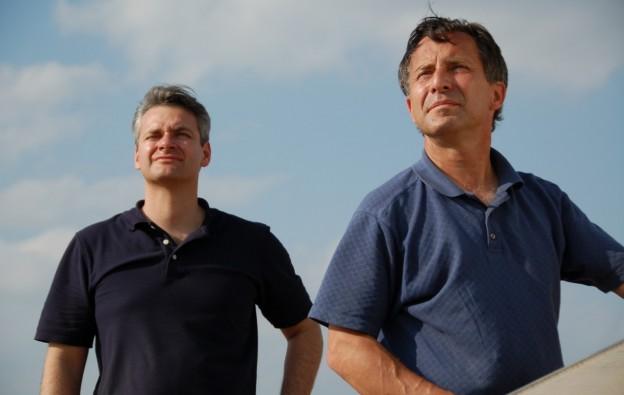Three storm chasers among dead from last week’s Oklahoma tornadoes
Carl Young, left, and Tim Samaras watch the sky in this promotional photo for the Discovery Channel series, Storm Chasers. (Photo courtesy of the Discovery Channel.)
At least fourten people died in the tornadoes that tore through Oklahoma Friday night.
And while eight of them remain unidentified, three of them, we now know, were veteran storm chasers Tim Samaras, his son Paul and their colleague Carl Young. Samaras, one of the stars of the now-canceled Discovery Channel show “Storm Chasers,” was a storm scientist and founder of the TWISTEX storm tracking system.
“He has been one of the first people to use miniaturized portable instruments to be placed in the path of tornadoes,” University of Oklahoma meteorology professor Howard Bluestein said, noting he’s known Samaras for 15 to 20 years.
While storm chasers are often denigrated as reckless thrill-seekers, many storm chasers provide valuable information for meteorological and scientific research.
“We’re trying to understand what the structure and behavior of tornadoes is,” Bluestein said. “We’d like to find out why it is that some storms produce tornadoes and others don’t. If you want to make measurements in them, you want to leave an instrument package in their path, you need to get relatively close and then get out of the way.”
They’re also often an early warning system for the National Weather System, providing visual confirmation of tornadoes on the ground, their size and their path.
But one growing hazard to professional storm chasers is the prevalence of amateur storm chasers, Bluestein said.
“Probably 90 percent of the people who are out storm chasing are amateurs who are out there just for the thrill of it,” Bluestein said. “This sometimes poses a problem for those of us who are trying to make measurements with instruments. We encounter traffic jams. We are out on very poor rural roads sometimes, which sometimes can be jammed with dozens and dozens of cars.”
Still, amateur storm chasers who post photos and videos of tornadoes online can be useful to the scientists.
“The people who are out collecting data for scientific purposes can’t be everywhere all the time. The amateurs can be scattered over a pretty broad area, and just receiving confirmation that there is a tornado in a certain area, getting a picture — if the (National) Weather Service sees that, that’s valuable information, because the weather service can then go out and issue a warning,” Bluestein said.
